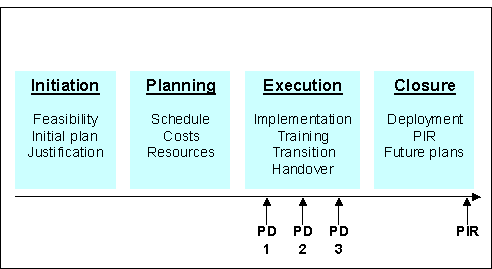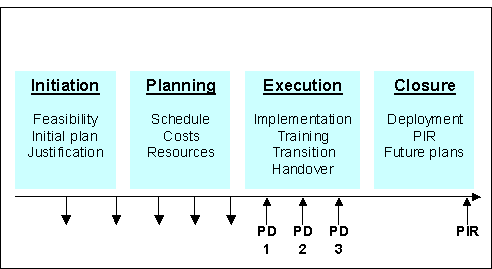
When should the project diagnostician be involved?
Here is the classical project life-cycle chart
again.

Figure 106.1: Diagnostic reports
The obvious points for a project diagnosis are during the Execution phase. A project diagnosis is hardly
relevant to the Initiation phase, which should involve a good deal of re-thinking and of testing new ideas and alternative
solutions. A project diagnosis is unlikely to be useful during the Planning phase. A project diagnosis will have no purpose during
the Closure phase, which will encompass the PIR.
So, the answer to the question "When should there be a project
diagnosis?" is "At reasonable intervals or whenever management wants, throughout the Execution
phase".
But when should the project diagnostician be involved?
Imagine if the project diagnostician became
involved for the first time at the first project diagnosis, which is shown above as "PD1". The project diagnostician
would need to:
- understand the project objectives, defined within the Initiation phase;
- understand the project justification, including the cost justification, benefits and rate of return defined during the Initiation phase;
- understand the nature of the project deliverables and outcomes, defined within the Initiation phase;
- understand the project charter, including the project scope, developed during the Initiation phase;
- understand the project plan, developed during the Planning phase;
- understand the project budgets, developed during the Planning phase;
- understand the project resources and their scheduling, developed during the Planning phase;
- understand the project reporting rules, developed during the Planning phase; and
- understand the nature and duration of any contracts with external service providers, developed during the Planning and Execution phases.
This is all in addition to gaining knowledge of the current project status.
A project diagnosis looks as if it might take some time to complete. Speed is the essence of a project diagnosis. There must be a better way.
Obviously, there is. Project diagnosticians should be involved from the earliest stages of projects. Although the time spent by them on the project will be the same, the time spent during the Execution phase, actually doing project diagnostics, will be less.

Figure 106.2: Diagnostic actions
| You may be tempted to think "If I engage a consultant who has lots of experience with project diagnostics, then they'll be able to spot the common errors straight away, so I only need to bring them in during the Execution phase. You would be wrong. Any experienced project diagnostician will tell you that every project is different, and that a project diagnosis will not usually be successful until it focuses on those issues that are unique to the project. You don't need a project diagnostician to tell you whether the project is on schedule. The project manager knows that. |
Copyright © 1996-2025